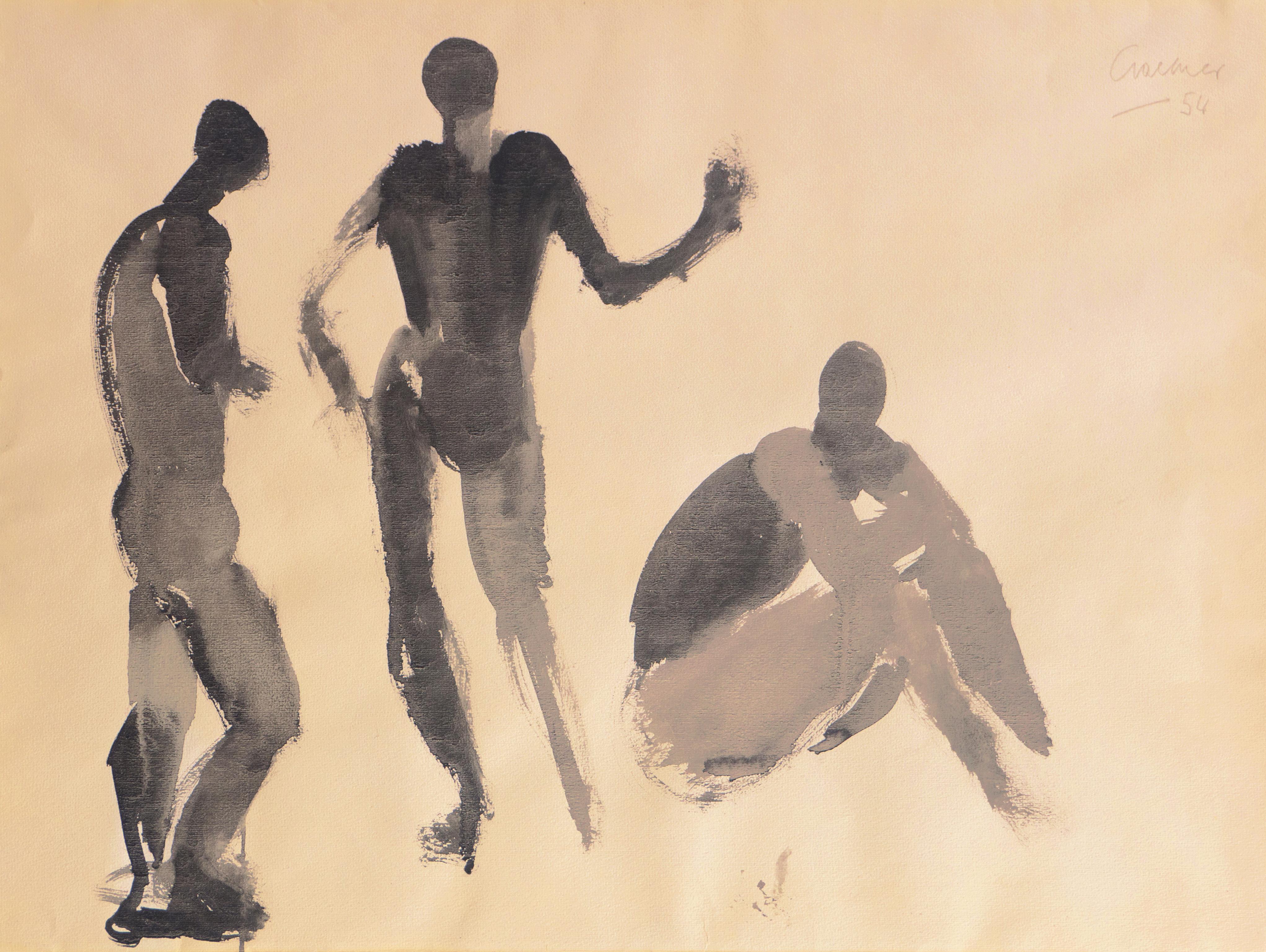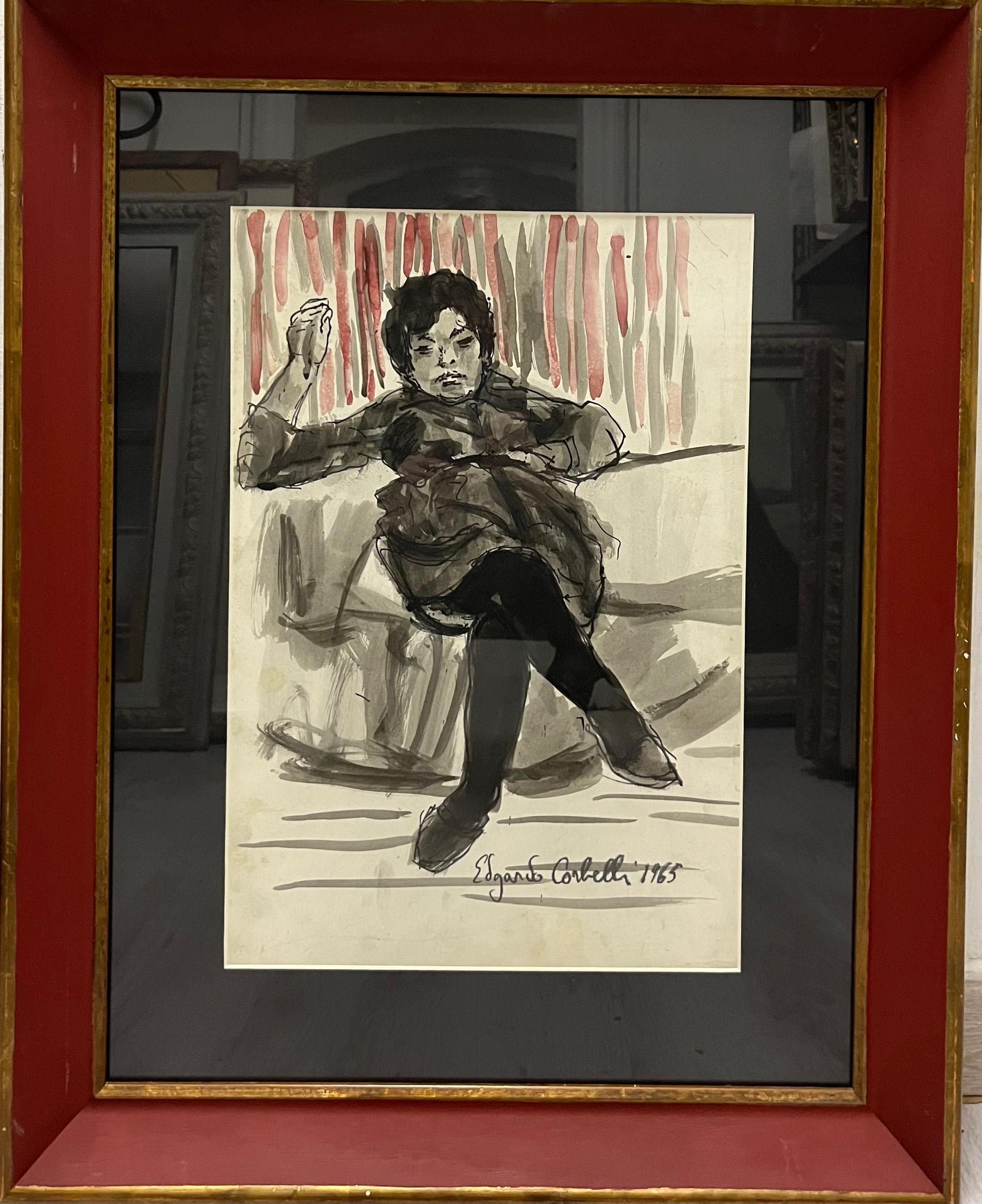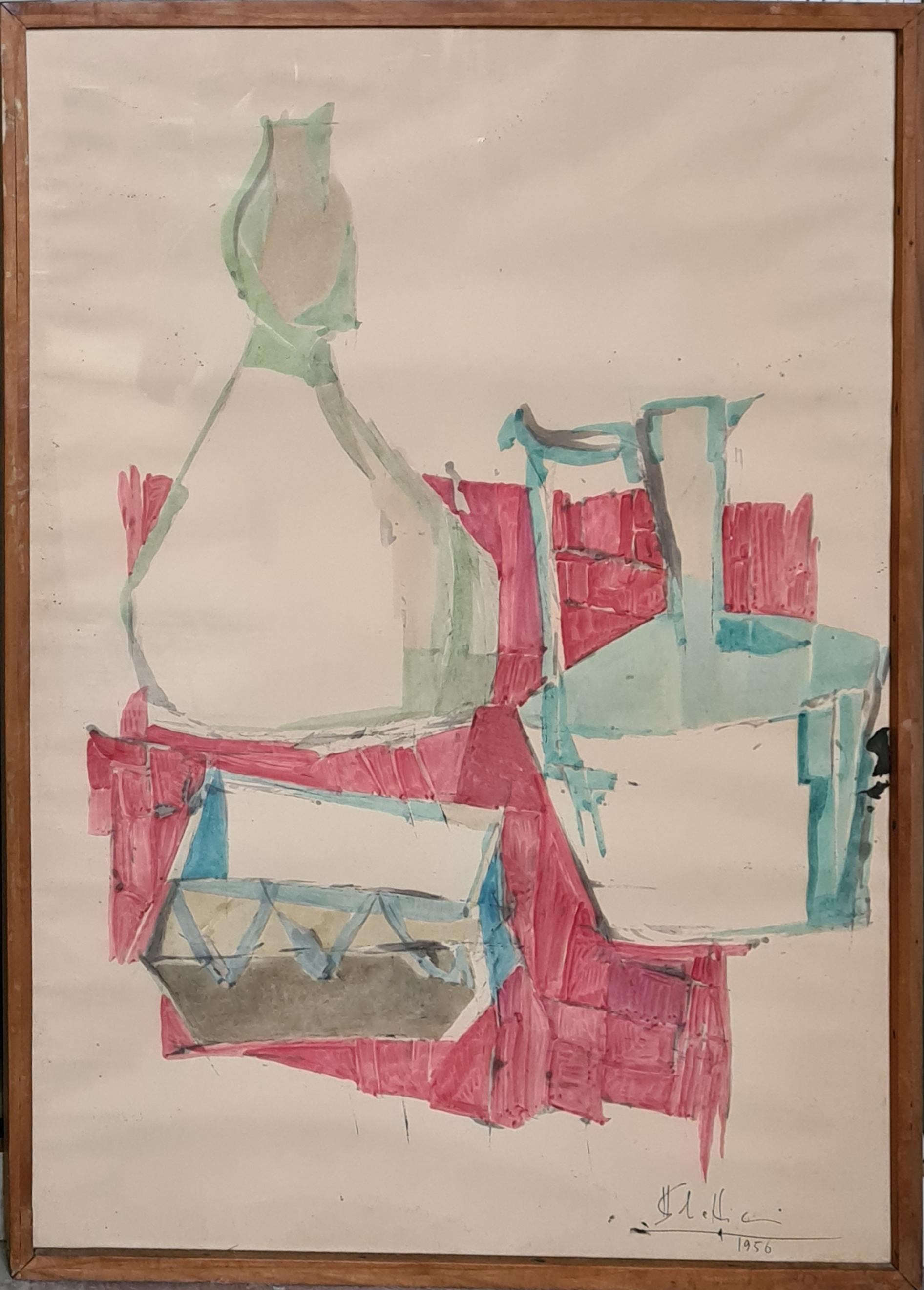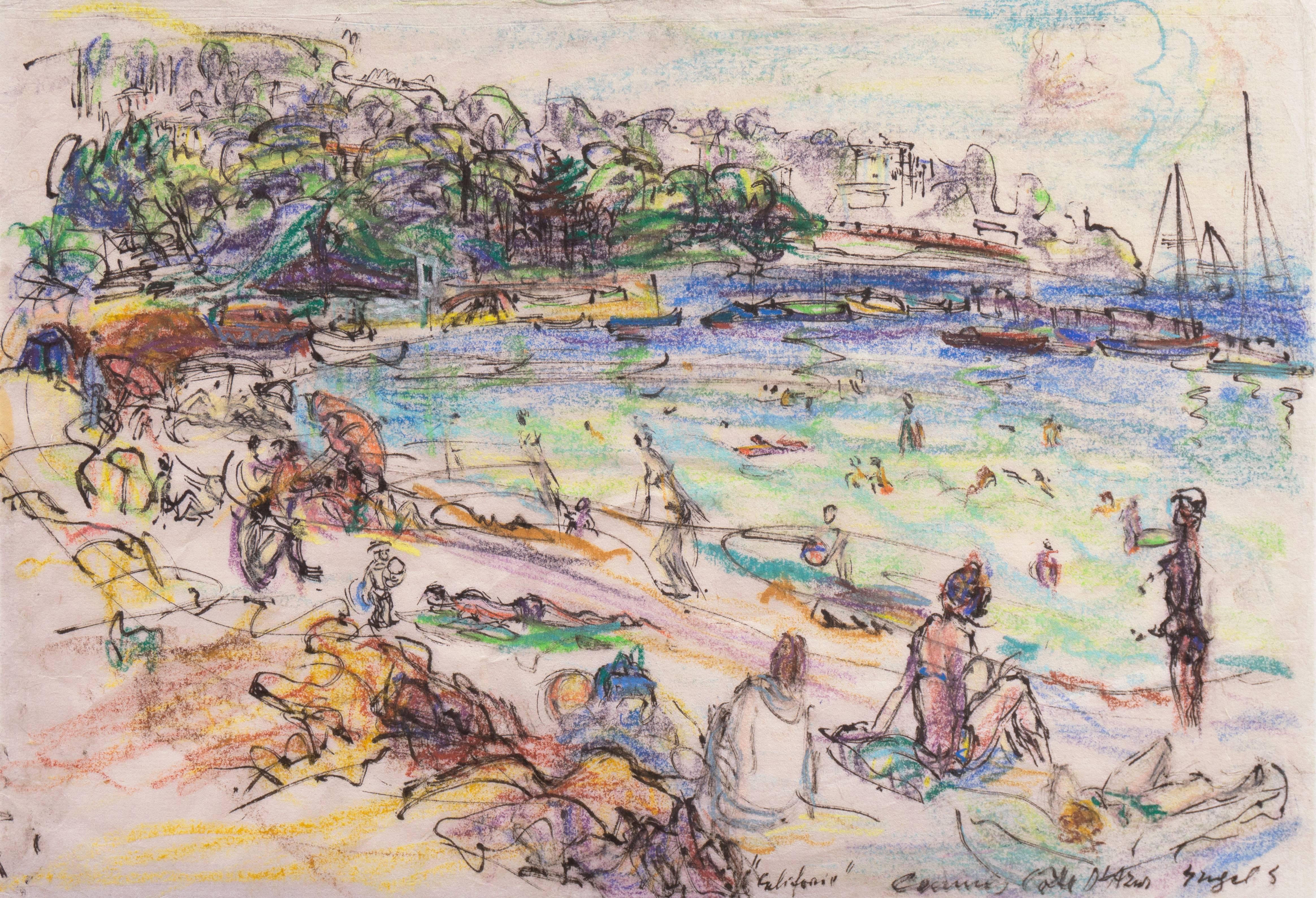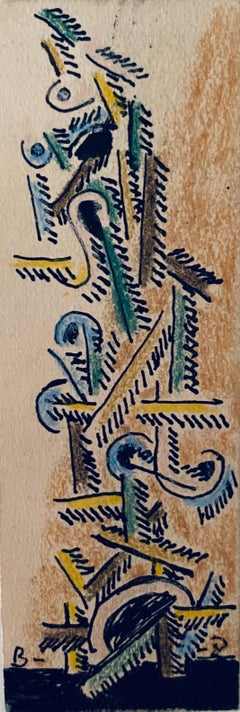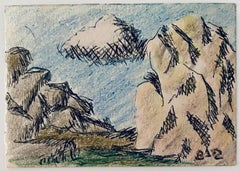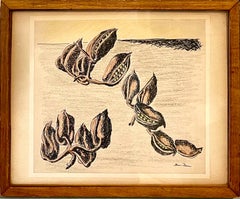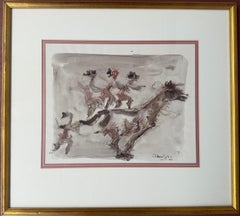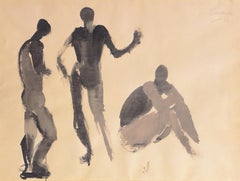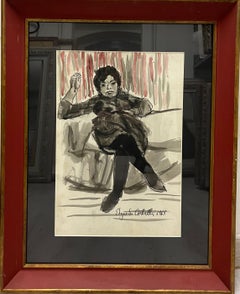Items Similar to Expressionist Figure Study
Want more images or videos?
Request additional images or videos from the seller
1 of 6
Sigmund MenkesExpressionist Figure Study
About the Item
Genre: Expressionist
Subject: Figures
Medium: Ink
Surface: Paper
Dimensions w/Frame: 14 1/4" x 12 1/4"
Zygmunt (Sigmund) Menkes
born in Lviv (Galicia, Austro-Hungarian Empire) Polish painter of Jewish origin, born in 1896 in Lvov, died in 1986 in Riverdale, New York. Member of the École de Paris group in the 1920s and 1930s. From the beginning of 1935 he lived and worked in the United States; he was a representative of the Expressionist Colorism movement.
Menkes began his artistic studies in 1912 at the Industrial School in Lviv. At the same time he worked as a restorer of rural churches. Between 1919 and 1922 he supplemented his studies at Krakow's Academy of Fine Arts and in 1922 expanded on this education and broadened his artistic skills in the private studio of Alexander Archipenko in Berlin. In 1923 Menkes settled in Paris, where he became a member of the École de Paris - a community that was primarily made up of artists hailing from Central and Eastern Europe who rented inexpensive studios in the "La Ruche" building in the Montparnasse district. Menkes developed close friendships with Eugeniusz Zak and Marc Chagall. Two years later, Menkes made the decision to settle permanently in France. He participated in a series of the city's salons, including the Salon d'Automne (1924, 1925, 1927), the Salon des Independants (1925-1928), and Tuileries Salon (1928, 1929, 1931, 1938). He presented his works in a number of Parisian galleries, among them, the Bernheim, de France, and Le Portique. In 1930 the artist traveled to the United States to present his work in Cleveland and New York. He also exhibited his paintings in Canada and England. He visited Poland frequently, spent time in Berlin in 1928, and toured Spain with Artur Nacht-Samborski in 1935, moving to the United States the same year.
In 1936 Menkes had his first solo exhibition in New York at the Sullivan Gallery on 57th Street. He also worked with the Associated American Artists Gallery and the French Art Gallery, and for years was a lecturer at the Art Students League. Solo exhibitions of his work were organized by the Galerie Le Portique in Paris (1928), the Friends of Fine Arts Society in Lviv (1930), and at the Jewish Society for Support of the Fine Arts in Warsaw (1931). In Poland the artist was a member of groups with a Coloristic orientation, including Nowa Generacja (New Generation) and Zwornik (Keystone), participating in their exhibitions in Lviv (1932, 1935) and Warsaw (1935, 1938). Menkes received a series of important distinctions for his work, including the Carol H. Beck Medal of the Pennsylvania Academy of Fine Arts (Philadelphia, 1943), the Gold Medal of the Corcoran Gallery (Washington, D.C., 1947), the Andrew Carnegie Award of the National Academy of Design (New York, 1955), and the Alfred Jurzykowski Award (New York, 1967).
Menkes's repertoire included figural compositions, portraits, nudes, still lifes, and landscapes. Early in his career his paintings exhibited a Fauvist aesthetic. Menkes's creative stance was especially strongly influenced by the work of Henri Matisse. Women depicted in interiors were a frequent motif; their approximated shapes were surrounded by fluid, bending contour lines that at times broke free of the color areas they surrounded. There was a decorative value in his canvasses, deriving from the inclusion of various fabric and wallpaper designs in the composition. Menkes also frequently painted scenes from the lives of the Jewry, depicting religious rituals and rabbis penetrating the words of the Torah. With time he intensified the expressiveness of his paintings, using only color patches to build forms, placing paint on canvas quickly and spontaneously. The artist's signature, signed with vigor in vermilion red, was also an important element in the structure of his compositions. Menkes's works of the late 1920s and the 1930s are compared with Chaim Soutine's Expressionistic formulas of representation. The artist drew his iconography from the Bible, saturating his religious scenes with nostalgia (Ecce Homo). His landscapes, painted in provincial towns and the mountains of southern France, emanate sensuality and demonstrate the artist's extreme sensitivity for the qualities of color and light. Menkes also created a moving series of World War II paintings depicting Jews enclosed in the Warsaw Ghetto and murdered there by the Nazis. These works were distinct for their washed out dominant blues and grays. In time the artist began to paint increasingly complicated configurations of lines, thickened line configurations, and richly textured planes. His expansive still lifes and interior scenes - often depicting the artist's studio in Riverdale, New York - were composed of balanced, multi-directional configurations of lines. Figures and objects were melded ever more precisely with backgrounds, while his color schemes, dominated by hues of blue, black and white, evoked nostalgia. Lively accents were restricted to small patches of pink and yellow. In his later works, which bordered on abstract allusions, we encounter a radical turn towards geometric forms painted in a range of intense, strong, contrasting colors. In addition to painting oils on canvas, Menkes produced gouaches, watercolors, and drawings. He also created a series of sculptures, primarily during a prolonged visit to Italy with Jacques Lipchitz.
The work of Mr. Menkes, an Expressionist, won many awards and hangs in major art institutions and private collections, including the recently closed Museum of the Jeu de Paume in Paris; the Philadelphia Museum of Art; the Whitney Museum in Manhattan; the Wichita (Kan.) Museum; the Newark Museum; the Corcoran Museum in Washington; the Cranbrook Academy in Detroit; the Jewish Museum in Manhattan; the Betsalel Museum in Jerusalem, and the Tel Aviv Museum.
Among the awards he received were the Clark Prize of the Corcoran Gallery, in 1941; the Carol H. Beck Medal of the Pennsylvania Academy, in Philadelphia, in 1943; the Andrew Carnegie award from the National Academy of Design, in Manhattan, in 1955, and the National Academy award for foreign painters, in 1963.
- Creator:Sigmund Menkes (1896 - 1986, American, Polish)
- Dimensions:Height: 14.25 in (36.2 cm)Width: 12.25 in (31.12 cm)
- Medium:
- Movement & Style:
- Period:
- Condition:frame has some wear.
- Gallery Location:Surfside, FL
- Reference Number:1stDibs: LU38211809392
About the Seller
4.9
Platinum Seller
Premium sellers with a 4.7+ rating and 24-hour response times
Established in 1995
1stDibs seller since 2014
1,755 sales on 1stDibs
Typical response time: 1 hour
- ShippingRetrieving quote...Shipping from: Surfside, FL
- Return Policy
Authenticity Guarantee
In the unlikely event there’s an issue with an item’s authenticity, contact us within 1 year for a full refund. DetailsMoney-Back Guarantee
If your item is not as described, is damaged in transit, or does not arrive, contact us within 7 days for a full refund. Details24-Hour Cancellation
You have a 24-hour grace period in which to reconsider your purchase, with no questions asked.Vetted Professional Sellers
Our world-class sellers must adhere to strict standards for service and quality, maintaining the integrity of our listings.Price-Match Guarantee
If you find that a seller listed the same item for a lower price elsewhere, we’ll match it.Trusted Global Delivery
Our best-in-class carrier network provides specialized shipping options worldwide, including custom delivery.More From This Seller
View AllAbstract Drawing Watercolor Painting Totem Column Jewish American Modernist WPA
By Ben-Zion Weinman
Located in Surfside, FL
Miniature Abstract Totem. Signed with initials.
Provenance: Virginia Field, Arts administrator; New York, N.Y. Assistant director for Asia House gallery. (she was friends with John v...
Category
Mid-20th Century Expressionist Abstract Drawings and Watercolors
Materials
Ink, Watercolor
Pastel, Ink Drawing Rocks And Cloud Landscape Jewish American Modernist WPA
By Ben-Zion Weinman
Located in Surfside, FL
Miniature Landscape
Provenance: Virginia Field, Arts administrator; New York, N.Y. Assistant director for Asia House gallery. (she was friends with John von Wicht and Andy Warhol)
Born in 1897, Ben-Zion Weinman...
Category
Mid-20th Century Expressionist Landscape Drawings and Watercolors
Materials
Pastel, Ink, Watercolor
Expressionist Ink, Pastel, Crayon Drawing Jewish American Modernist Ben Zion WPA
By Ben-Zion Weinman
Located in Surfside, FL
Expressionist ink and pastel crayon drawing of beans (carobs, flowers?) in pods
Hand signed.
Born in 1897, Ben-Zion Weinman celebrated his European Jewish heritage in his visual wo...
Category
Mid-20th Century Expressionist Still-life Drawings and Watercolors
Materials
Paper, Oil Crayon, Pastel, Ink
German Expressionist Drawing, Watercolor Painting Jules Pascin Cuba Scene 1910
By Jules Pascin
Located in Surfside, FL
Genre: German Expressionist
Subject: Woman, Cuban Scene
Medium: watercolor paint, ink or pencil
Surface: Paper
This is hand signed lower right.
There is an inscription at bottom e...
Category
1910s Expressionist Figurative Drawings and Watercolors
Materials
Paper, Ink, Watercolor
Expressionist Miniature Drawing Wheat Stalks American Modernist Ben Zion WPA
By Ben-Zion Weinman
Located in Surfside, FL
Expressionist ink drawing of wheat stalks
There is an inscription "Happy New Year" on verso
Hand signed
Framed it measures 7.75 X 5.75
The actual paper is 3 X 3.5
Born in 1897, Ben-...
Category
1950s Expressionist Still-life Drawings and Watercolors
Materials
Ink
Expressionist Color Drawing Cobalt Glass Vintage Frame Modernist Ben Zion WPA
By Ben-Zion Weinman
Located in Surfside, FL
Expressionist ink and pastel crayon drawing of flowers in vase.
Framed in a vintage cobalt blue glass original frame
Hand signed and dated
Framed it measures 13.5 X 10.5
The actual ...
Category
1950s Expressionist Still-life Drawings and Watercolors
Materials
Paper, Oil Crayon, Pastel, Ink
You May Also Like
Drawing, pastel, ink and colored pencils. "Free spirits"
Located in Bogotá, Bogotá
Pastel, Pencil, petal flowers, Color and Ink on Paper.
The base of this drawing is Fabriano paper of 120g /m2. I use natural dyes of flowers, herbs, leaves, bark of trees as the fir...
Category
2010s Expressionist Portrait Drawings and Watercolors
Materials
Paper, Pastel, Ink, Pencil, Color Pencil
Circus Performers
By Chaim Gross
Located in Lake Worth Beach, FL
Circus Performers 1960
work size 11x13.5
Chaim Gross (1904 Austria–1991 USA) will always be remembered as one of the foremost American artist : painter, sculptors who practice direct...
Category
1960s Expressionist Figurative Drawings and Watercolors
Materials
Paper, Ink, Watercolor, Pen
'Three Figures', Mid-century German Expressionist, Düsseldorf, Venice Biennale
By Kurt Craemer
Located in Santa Cruz, CA
Signer upper right, 'Craemer' for Kurt Craemer (German, 1912-1961) and dated 1954.
Born in Saarbrucken, Craemer first attended the Academy of Cologne where he worked under Friedrich Ahlers-Hesterman in 1928. He then traveled to Paris with his teacher, where he was introduced to the work of Henri Matisse. From 1930-33, Craemer lived in Düsseldorf where he continued his studies at the Art Academy under Paul Klee. With the Nazi's ascent to power late that year, Craemer moved to Italy and lived there at the Art colony in Ischia until the end of the war when he moved to Positano.
Throughout the 1950's, Kurt Craemer continued to live in Italy exhibited with success internationally, including at the Venice Biennale...
Category
1950s Expressionist Figurative Drawings and Watercolors
Materials
Paper, Ink
"Luisa on the sofa" Watercolor and black ink cm. 33 x 46 1965
By Edgardo Corbelli
Located in Torino, IT
woman, , Italian painter,Red,Black
Edgardo CORBELLI (Turin, 1918 - 1989)
From the traditional composition of the 1930s, the painting of Corbelli leads to technical and expressive re...
Category
1960s Expressionist Figurative Drawings and Watercolors
Materials
Ink, Watercolor
$2,732 Sale Price
20% Off
Mid Century Italian Tablescape With Red Cloth, 1956, Circle of Giorgio Morandi
By Giorgio Morandi
Located in Cotignac, FR
Mid Century Italian watercolour on paper of a tablescape, signed and dated (1956) bottom right. The artist is currently unknown.
Presented under glass in original, period plain woo...
Category
Mid-20th Century Expressionist Still-life Drawings and Watercolors
Materials
Paper, Ink, Watercolor
'The Cote d'Azur', Paris, Salon d'Automne, Post-Impressionist California Artist
By Irma Engel Grabhorn
Located in Santa Cruz, CA
Signed lower right 'Engel G' and titled, 'Californie ... Cote d'Azur'.
Born in Badenweiler, Irma Leisinger first studied in Paris with Andre Lhote from 1926. In 1930, she entered th...
Category
1960s Expressionist Landscape Drawings and Watercolors
Materials
Paper, Oil Pastel, Ink
Recently Viewed
View AllMore Ways To Browse
Vintage Figural
Vintage Figure
Timor Figure
Yellow Color Study
Figure In Yellow
World War Ii Paintings
Figure Drawings
Figure Study Drawing
Expressionist Figure
Italian Expressionist
Jewish Drawing
1920s French Drawing
Expressionist Early 20th Century
Red Figure Drawing
Multi Figure
Red Line Drawings
Jerusalem Drawing
Expressionist Painting Pink And Blue

